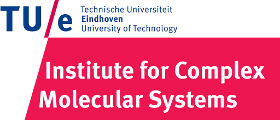Team:TU-Eindhoven/FNRPromotor
From 2013.igem.org
Pascalaldo (Talk | contribs) (→The Model) |
Pascalaldo (Talk | contribs) (→The Model) |
||
| Line 20: | Line 20: | ||
{{:Team:TU-Eindhoven/Template:Float | position=left | size=12 }} | {{:Team:TU-Eindhoven/Template:Float | position=left | size=12 }} | ||
<html>$$ | <html>$$ | ||
| - | \eqalignno{\ce{$T + P\,$ &<=> $TP} & (1) \\ | + | \eqalignno{\ce{$T + P\,$ &<=> $TP$} & (1) \\ |
| - | \ce{$P + T\,$ &<=> $PT} & (2) \\ | + | \ce{$P + T\,$ &<=> $PT$} & (2) \\ |
| - | \ce{$TP + T\,$ &<=> $TPT} & (3) \\ | + | \ce{$TP + T\,$ &<=> $TPT$} & (3) \\ |
| - | \ce{$T + PT\,$ &<=> $TPT} & (4) | + | \ce{$T + PT\,$ &<=> $TPT$} & (4) |
}$$ | }$$ | ||
</html> | </html> | ||
Revision as of 13:25, 9 September 2013



Contents |
FNR Promotor
To let the bacteria sense low oxygen concentrations, a FNR promotor was used in this research. The promotor that was chosen is not a default one, since it is a so called tandem promotor. That is, it contains two FNR binding sites. The kinetics of this promotor are therefore different than the promotor previously described in the Decoy Sites model. Here the necessary adaptations of the Decoy Model to account for this special promotor will be described.
Promotor Design
The promotor that was used in this research was taken from research by Barnard et al.BusbyFNRAnne M.L. Barnard, Jeffrey Green, and Stephen J.W. Busby, Transcription regulation by tandem-bound FNR at Escherichia coli promoters. Journal of bacteriology 185.20, 5993-6004 (2003). The research showed the promotor (FF(-91.5)FF(-41.5)) expresses an 1.8 times higher activity than the most commonly used single binding site FNR promotor (FF(-41.5)). From hereon the tandem FF(-91.5)FF(-41.5) promotor will be referred to as the FNR-tandem promotor and default FF(-41.5) will be called FNR-single promotor. The global design of the FNR-single and FNR-tandem promotor are displayed below:
-130 -120 -110 -100 -90 -80 -70 -60 -50 -40 -30 -20 -10 0
| | | | | | | | | | | | | |
(FNR-single) **********************************TTGAT****ATCAA**********************CATAAT*******
(FNR-tandem) **********************************TTGAT****ATCAA************************************TTGAT****ATCAA**********************CATAAT*******
(consensus sequences) ______________ ______________
The FNR consensus sequences contain two binding sites, each for one monomer of the FNR dimer.
The Model
When converting the knowledge about the FNR-tandem promotor to a model, it had to be kept in mind that there is very few measurement data of the promotor available. The only data that can be acquired are the binding and disscociation ratios of FNR to one consensus site and the relative activity of the FNR-tandem promotor with respect to the FNR-single promotor. The relative activity of the FNR-tandem promotor suggests that there is minimal hindrance between the two bound FNR proteins, but there also is no significant synergy. Using this information the tandem characteristics of the promotor were incorporated into the model. Hereto the following reactions were added:
References
 "
"



